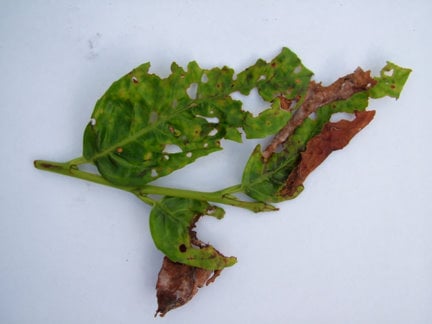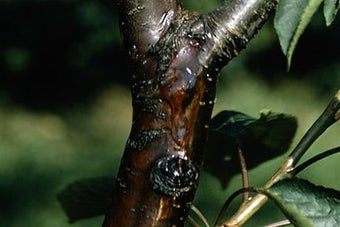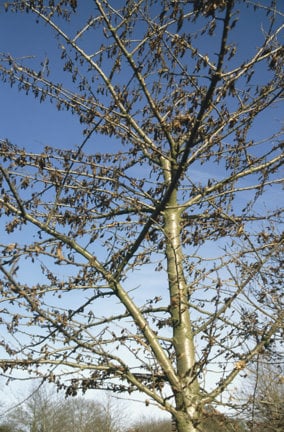
Quick facts
Common name - Powdery mildew, leaf spot fungi and bacterial shothole
Scientific name - Podosphaera spp., Stigmina carpophila, Eupropolella britannica and Pseudomonas syringae
Plants affected - Cherry laurel (Prunus laurocerasus); most of the diseases also found on Portuguese laurel (Prunus lusitanica)
Main causes - Fungi and bacterium
Timing - Spring to autumn
What are laurel leaf diseases?
Leaves of cherry laurel (Prunus laurocerasus) are often affected by (Podosphaera species), by leaf spot fungi (Stigmina carpophila and Eupropolella britannica) and bacterial shothole (Pseudomonas syringae), all of which can cause holes, tattering and distortion in the leaves. Most of the diseases (apart from Eupropolella) are also found on Portuguese laurel (Prunus lusitanica).
Symptoms
Laurels suffering from leaf diseases may show the following symptoms;
Powdery mildew:
- initially grows over the leaf surface, visible as a white powdery coating, particularly on the underside of the leaf
- Later, underlying tissues go brown and die
- Unusually for powdery mildew infections, the brown tissue then drops out, often leaving irregular holes in the leaves, and tattered edges which look more like insect damage than disease. The margins of the holes often have a corky, brown appearance
Leaf spot fungi and Bacterial shothole:
- The leaf spot pathogens Stigmina and Eupropolella cause brown spots on the leaves. The centres of the spots may eventually fall out, leaving irregular holes in the leaves that resemble damage from shotgun pellets – hence 'shot-hole'. Spots caused by Eupropolella are larger than those of Stigmina and sometimes have fungal fruiting bodies visible, and can lead to large parts of the leaf being shed
- The bacterium Pseudomonas syringae causes water-soaked lesions that enlarge and turn tan with chlorotic (yellowing) halos. After leaf defences halt the enlargement of a lesion, the dead part eventually falls out – again referred to as 'shot-hole'

Control
The RHS believes that avoiding pests, diseases and weeds by good practice in cultivation methods, selection, and encouraging or introducing natural enemies, should be the first line of control. If chemical controls are used, they should be used only in a minimal and highly targeted manner.
Non-chemical control:
- Little can be done by cultural means to prevent infections when conditions are suitable. Plants may sometimes 'grow through' the problem, with new leaves being unaffected when growing conditions change so that they are less conducive for the diseases
- If the attack is very unsightly, consider trimming to remove affected leaves and encourage new growth. However, avoid heavy pruning as this will stress the plants and may aggravate the problem
- Feeding may be helpful, although laurel is usually robust enough not to require it
Fungicides
The RHS recommends that you don't use fungicides. Fungicides (including organic types) may reduce , impact soil health and have wider adverse environmental effects. If you do intend to use a fungicide, please read the information given in the link and download below to ensure that use, storage and disposal of the product is done in a responsible and legally compliant manner.
The products listed in the ‘Fungicides for gardeners’ document below are legally available for use by home gardeners in the UK. This information is provided to avoid misuse of legal products and the use of unauthorised and untested products, which potentially has more serious consequences for the environment and wildlife than when products are used legally. Homemade products are not recommended as they are unregulated and usually untested.
There is no specific information available on the efficacy of any home garden fungicide against the fungal leaf spot diseases of laurel. No products are available to home gardeners that will have activity against bacterial shothole.
Download
Fungicides for gardeners (Adobe Acrobat pdf document outlining fungicides available to gardeners)
Link
Biology
The pathogen Podosphaera pannosa also attacks roses and a distinct variety attacks peaches. Podosphaera tridactyla is found on numerous host species of the genus Prunus. Recent analysis work has also separated out a number of new species from Podosphaera tridactyla, including Podosphaera pruni-avium on cherry laurel and Podosphaera pruni-lusitanicae on Portuguese laurel.
As with other powdery mildews, these species grow initially over the leaf surface, feeding from the tissues but not killing them, and producing airborne spores which spread infection. Later the tissues die and, unusually for powdery mildew infection, drop out leaving holes and tattered edges to the leaves. An overwintering stage is of minor importance, most survival through the winter is as mycelium on the evergreen leaves.
The shothole fungi survive the season in lesions on twigs, or leaves and produce spores that are mainly dispersed by rain. Infections occur in young leaves, but as they expand the infection stabilises and the healthy leaf tissue pulls away from the lesion which drops out, leaving a hole. Severe attacks result in a ragged appearance to the leaves. Stigmina carpophila attacks other Prunus species but Eupropolella britannica has only been recorded on Prunus laurocerasus.
The bacteriumPseudomonas syringae is readily spread in wind-driven rain and penetrates host tissues through natural openings or wounds. The bacteria survive on plant tissues when the conditions are unfavourable to multiplication and infection.
New disease alert: The bacterium Xanthomonas arboricola pv. pruni also affects Prunus species, in particular apricot, peach and plum but also cherry laurel. The disease is not established in the UK but has been intercepted on imported plants of cherry laurel. Symptoms include shothole, fruit and leaf spotting, stem cankers and severe defoliation. Any suspected cases on nursery stock or newly-planted plants should be reported to the relevant plant health authority, whose contact details can be found on the UK Plant Health Information Portal.










